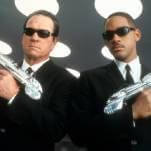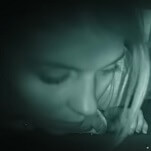At this point in his career, director Mamoru Oshii has established a signature mood of detached, autumnal melancholy, which predominates over his films regardless of their genre, and no matter whether they’re live-action (Avalon, Stray Dog) or anime (both Ghost In The Shell movies, the first two Patlabor films). The same holds true for the science-fiction/alternate-world period piece The Sky Crawlers: It’s packed with grueling aerial combat and life-or-death situations, not to mention sex and killing, and yet the entire film feels like a slow, sleepy summer daydream. Oshii’s love of long takes, drifting clouds in wide blue skies, melancholy waves of piano music, and relentlessly wistful moods predominate over any action, turning even murder into just another regrettable moment of exquisitely tuned, elegantly abstracted emotional torment.
The film focuses on a band of teenage European pilots fighting a war against a vaguely defined enemy. The pilots all have the same bland, unlined faces and saggy hair, and the differences between their personalities are minimal. But the lack of detail, both in their design and in their world, is intentional, for reasons that only gradually become clear, as screenwriter Chihiro Itou, working from a series of Hiroshi Mori novels, doles out the occasional elusive revelation. Eventually, one character mentions that the pilots are all “Kildren,” and will never grow up, though precisely what any of that means is a matter for the end of the film. Meanwhile, they fly and fight and die. A newcomer to the base takes up with a local escort whose motives for bedding him and watching over him are as mysterious as anything else in the film. He investigates his fellow Kildren, uncovering one mystery having to do with his predecessor, and another regarding the enemy ace known as “The Teacher.” And he stands around, passively accepting and dutifully melancholy, as more focused souls question what it’s all about.
As usual, Oshii’s clean, painterly, fantastically rich images are an animation lover’s dream, meant to soothe fans into a restful state of acceptance where they take in the plot’s slow beats rather than impatiently anticipating them. There’s virtually no urgency to the film—even the final, crucial reveal comes after the credits, where it could easily be missed, and it’s as gentle and subtle as everything else in Sky Crawlers. Oshii intermittently plays with modern action-movie dynamism, with rapid camera movements and documentary-style leaps in focus during the chilling dogfights, but for every beautifully realized combat sequence, there’s another one where the characters silently, sadly regard each other, or Oshii’s trademark, a basset hound, lopes cheerfully around the base. It isn’t a film for the impatient, and it’s more about establishing a mood than telling a story. But it’s a mood Oshii has spent years crafting, and his experience with that work shows through in every graceful frame.
Key features: A couple of 30-minute featurettes exploring the film’s sound effects, and all the places Oshii and his animators visited and photographed to give the film its precise, impeccably detailed look.









































